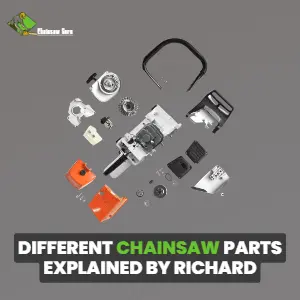
Luckily, explaining and understanding a chainsaw is much simpler than other machines. It comes with a compact set of parts and features that can be grabbed in no time for each one of us.
Firstly, we’ll be dividing the tool into two mechanical modules. The first one is a chain bar that contains a saw blade converted into a chain. The chain bar is put around a long metal bar that varies in length with different chainsaw models.
The second one is a power source, it can be a gas engine or an electric-powered chainsaw to run the motor. The power numbers determine the cutting speed and how many thick materials an individual is able to deal with.
The rest parts we will be mentioning will come under the spectrum of the above two categories. So, let’s study closely the parts of a chainsaw to have better awareness regarding buying them and operating them further.
Complete Detail of Chainsaw Parts in 2022

Bar and Chain:
Although they both are separate parts of a chainsaw but widely considered single as they are closely bonded together. A saw bar converted into a chain runs over a metal bar that includes sprockets. The sprockets are to be maintained properly for the smooth functioning of the chainsaw.
Chain Brakes
These are included in the chainsaw to prevent chain kickback in case of a mechanical failure. This is essential to maintain user safety and prevent serious injuries. Any malfunctioning can cause a kickback so chain brakes ensure that the chain stops rotating immediately over the metal bar.
Handle Bar
This is the most important part of chainsaw related to user intuitiveness. A rubber grip, ergonomic design, and anti-vibration, heated, etc are the commonly desired features of a handlebar.
Pull Cord
A small rope with a plastic handle makes up a pull cord that gets the chainsaw ignited. It is mostly found with gas chainsaws. A convenient pull cord is a must-have or else it can cause delays to get started out in the middle.
Power Switch Button
This feature is associated with electric chainsaws. At the push of a button, a machine can be switched on and off with the availability of electric power. It provides the best user intuitiveness related to getting the tool started.
Oiling Tank
For mechanical maintenance to be done automatically, an oiling tank is provided. Once a certain level of oil is maintained, the other mechanical parts such as the chain bar and the motor get their due share on their own. It leads to minimum user input for maintenance. Keep in mind that you cannot use literally any oil for chainsaws. Research the best bar and chain oils available online and get the one that meets your needs as well as the budget constraint.
Learn More About Chainsaw Oiling Below:
Do Electric Chainsaws Need Oil?
Air Filters
To keep the emissions levels reduced, air filters are commonly installed inside the engine. It also provides users with a better environment to operate and get the job done without causing any health problems to themselves.
Spark Plugs
A spark plug helps to ignite the fuel in the engine. Once the push button or a pull cord gives the signals, the spark plug ensures the motor has the fuel input for it to get started. A spark plug is commonly found in the machines and requires regular replacement when a motor runs for a certain period of time.
Learn More: How to Convert Chainsaw into Chopsaw?
Speed Triggers
Not much commonly found, but certainly a part of the tool that helps you to determine the speed of the chainsaw manually. You can deal with the motor performance on your own and set the speed at which you want your chain to rotate along with the metal bar sprockets.
Tensioning Knob
For you to have Tool-free chain adjustments, a chain tensioning knob is provided. While the things are to be dealt with in minimum time, a tool-free chain adjustment system provides a convenient user experience. It helps to adjust the chain properly in no time while doing the cutting job out there in the middle.
Frequently Asked Questions:
1. What are the parts of a chainsaw called?
A cutting tool like a chainsaw comes with three basic elements, i.e. an engine, also known as the power head, a guide bar, and a chain adjusted on that guide bar. When you start a chainsaw, the power head produces a centrifugal force that forces the chain to glide on the bar and that’s how the tool works in cutting thick wood logs and firewood, etc.
2. What is the sharp part of a chainsaw called?
Commonly known as blades or bucking spikes, the sharp part of the chainsaw helps penetrate the wood during the cutting process. Also known as dogs or bumper spikes, you can easily slice through a large tree when the blades of your chainsaw are sharpened enough. You can use a chainsaw sharpener for that purpose.
3. What is the thing you pull on a chainsaw called?
The thing that you pull on a chainsaw usually goes by the name of a rope start or a rewind start. Commonly called a pulling cord in a chainsaw, when pulled in a gas tool, the 2-stroke engine will get started with two to three firm strokes. Once started, you can use it to cut firewood or logs without any hassle.
4. What is a chainsaw clutch called?
A clutch or a centrifugal clutch present inside the engine controls its speed. If you focus on the speed and sound of the tool enough, it will produce more noise and vibration while you cut or slice a wood log. As soon as the tool disengages from the wood, it will come back to a lower speed level to help you save the fuel or remaining battery. That is how a centrifugal clutch works.
5. What do the L and H mean on a chainsaw?
Ever wondered what letters like L, H, and T actually mean on a chainsaw? Well, these are all synonymous with the speed. The L screw represents mixing the air and fuel during low RPM or when the chainsaw is not being used on a large trunk. H stands for High and during that time the tool is actively involved in a heavy-duty cutting task. T stands for idle and that’s when the chainsaw is on but not being used.
Final Takeaways: Parts of a Chainsaw in 2025
Although it was a bit of a technical aspect of the chainsaws, we made a profound effort to make it simple as possible.
Each of the parts plays a vital role in making the functionality complete and helps to fulfill the purpose.
If any of the parts of the chainsaw would go missing, it will either stop mechanical operation or lead to less user convenience on offer.
- How Many Watts Does a Pole Saw Use? - July 4, 2025
- How Long Is a Pole Saw? - July 3, 2025
- How Much Does a Pole Saw Cost? - July 2, 2025
